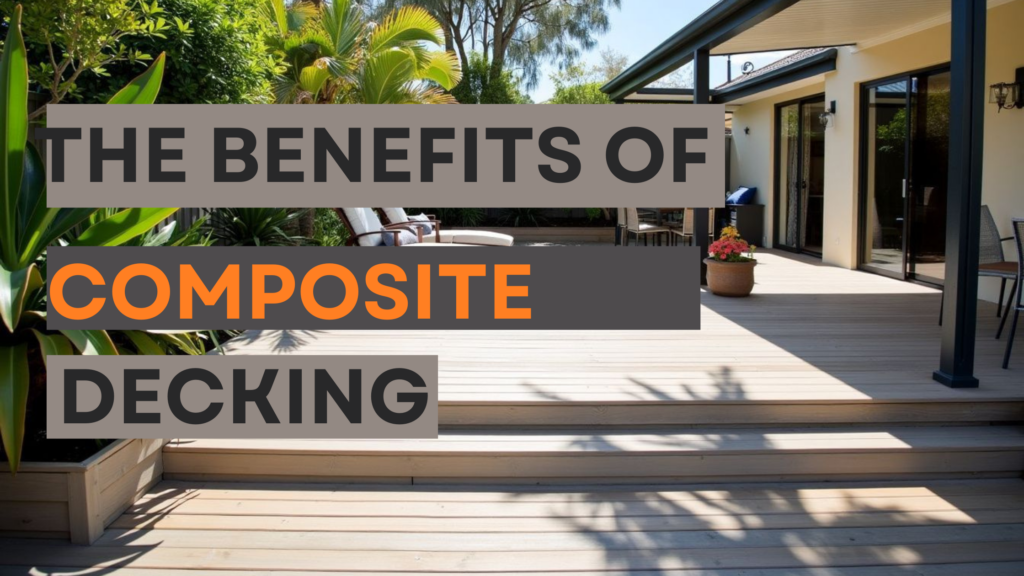The Benefits of Composite Decking
Your outdoor space needs a deck that can handle everything the weather throws at it. BiForm Solid Composite Decking, made with FSC-certified timber and recycled plastic, offers a solution.
This article will guide you through the benefits of choosing composite decking for your backyard oasis. Keep reading to find out more.
What is Composite Decking?
Composite decking, also known as wood plastic composite (WPC), offers a durable and low-maintenance alternative to traditional timber decking. It combines recycled materials with plastic to create a long-lasting, eco-friendly building material suitable for outdoor spaces.
Definition of Wood Plastic Composite (WPC)
Wood Plastic Composite (WPC) is a resilient construction material composed of wood fibres, plastics, and additives. Subjected to heat and pressure, it forms outdoor decks resistant to weathering and wear.
Quality timber, mostly procured from Forest Stewardship Council (FSC) approved forests, constructs the wood element in WPC. After kiln-drying to minimise moisture content to around 0.6%, these timbers transform into fine wood flour.
In terms of plastic, WPC utilises 100% recycled materials such as plastic bags, circumventing the need for non-recyclable UV-degradable virgin plastic.
Selecting materials holding environmental certifications like those from the FSC allows WPC decking to contribute to ecological forestry practices.
This product offers an avenue for recycling waste whilst lessening the effects of deforestation by re-purposing wood materials. Exhibiting features like recyclability at its life term’s end and minimal maintenance requirements during usage, WPC stands as an environmentally-friendly option for outdoor areas.
Comparison with Traditional Timber Decking
After learning about Wood Plastic Composite (WPC), we’ll explore how composite decking stands up to traditional timber decking. This comparison highlights key differences and advantages.
|
Feature |
Composite Decking |
Traditional Timber Decking |
|
Material |
Wood Plastic Composite (WPC) |
Softwoods like treated radiata pine or hardwoods like Kwila |
|
Maintenance |
No oiling, staining, or painting required |
Needs regular oiling, staining, or painting to maintain condition |
|
Durability |
Resists warping, rotting, and decay |
Can warp, rot, or decay over time without proper care |
|
Lifespan |
Long-lasting with consistent performance |
Varies; radiata pine: 15-25 years, hardwoods: 25-50 years |
|
Environmental impact |
Reduces deforestation impact, materials are recyclable |
Contributes to deforestation, mixed recyclability depending on type |
|
Design options |
Offers a variety of textures and colours, highly customisable |
Limited by the wood’s natural appearance, less customisable |
Composite decking provides an attractive, durable, and sustainable option for outdoor spaces, with less maintenance compared to traditional timber decking. This makes it a smart choice for homeowners looking to enjoy their decks with minimal upkeep
Performance and Durability
Composite decking provides exceptional longevity and durability compared to traditional timber options. It withstands weather and wear efficiently, making it a superior choice for outdoor spaces.
Longevity of Composite Decking
Composite decking boasts a longevity that makes it a smart choice for homeowners. The warranties it comes with range from 15 to 25 years, demonstrating its resilience against warping, rotting, and decay.
Engineered to withstand New Zealand’s severe weather, it doesn’t easily give in to UV degradation or wear and tear.
Deckorators® Voyage™ offers a solid 25-year warranty without any thermal expansion or contraction.
Hence, composite decking can be considered a long-term investment for your outdoor area. It minimises the necessity for routine replacements and effectively retains its visual appeal and structural integrity for extended periods.
Now we should proceed to understand how this decking withstands weather and wear.
Resistance to Weather and Wear
Composite decking stands up well against all sorts of weather and wear. It does not rot or decay like wood does. Bugs that eat wood can’t harm it. This makes your deck last longer without much trouble.
The materials used also stop mould from growing and protect the deck from the sun’s harmful rays. These decks are good for areas near water too, like pools or lakes.
Aesthetics and Design Options
Composite decking provides a diverse range of textures and hues, offering endless design possibilities for crafting your perfect outdoor living area. Its personalised choices accommodate personal tastes and customised designs, elevating the visual charm of any residential or commercial undertaking.
Variety of Textures and Colours
Composite decking offers a wide range of textures and colours to match any outdoor space design. With options like FORM 130 Boards available in five shades, FOREST Board in three, and FORM 140 Boards also offering five but made to order, you can find the perfect match for your deck.
Futurewood takes it up a notch with seven designer hues, ensuring there’s something for every taste.
The dual-faced design feature of these boards adds versatility. One side is smooth for a sleek look, while the other is grooved for extra grip. This choice lets homeowners customise their decks further beyond just colour and composition.
Ekodeck Classic decking even combines up to 90% reclaimed and recycled materials, making it an eco-friendly option without sacrificing style.
Customisation Potential
Moving from the vast array of textures and colours, composite decking offers unmatched customisation potential. Tools like BiForm Visualiser make it easy to design your deck online.
Outdure’s planning technology helps with both design and pricing, ensuring you can visualise your project before starting. This tech is perfect for a variety of settings including homes, businesses, and schools.
These tools allow for a high level of personalisation in outdoor spaces. With options for dual-faced boards, you can switch up the style without replacing the entire deck. The wide range of available colours and textures means every space gets its unique look.
Composite materials bring creativity to life in designing durable, low-maintenance decks that reflect personal style.
Environmental Impact and Sustainability
Composite decking provides substantial environmental benefits. Its use reduces the impact on deforestation and promotes sustainability by integrating recyclable materials. Furthermore, it minimises the carbon footprint connected to transportation and maintenance, thereby further enhancing its environmental sustainability.
Reduced Deforestation Impact
Choosing composite decking helps fight deforestation. This is because it uses recycled materials. For instance, Ekodeck Classic has up to 90% reclaimed and recycled content. Products like Futurewood offer a 15-year replacement warranty and are made from sustainable sources.
By picking these decks, you support responsible forest management.
Composite materials also promote environmental sustainability. They reduce the need for new wood, cutting down on tree cutting. Using composites means less pressure on forests and supports programmes like the Forest Stewardship Council (FSC).
This results in a smaller carbon footprint from both use and disposal of decking materials.
Recyclability of Composite Materials
Composite materials stand out because they make great use of recycled plastic and reclaimed wood. This mix helps keep waste out of landfills. For example, products like Ekodeck Classic are made with up to 90% reused materials.
These include bits of old wood and plastic that have found a new purpose. By picking such composites, you support efforts to cut down on the amount of rubbish we generate.
These decking options also promote a sustainable life cycle. They avoid using fresh resources that can harm the planet, like UV-degradable virgin plastic. Instead, they lean heavily on post-consumer materials that would otherwise add to greenhouse gas emissions by rotting away in dumps or needing burning.
So, choosing composite materials means you’re also choosing a greener future for our forests and reducing deforestation impact since less new wood gets chopped down for your deck projects.
Maintenance and Care
Maintaining composite decking is simple and requires minimal effort, ensuring a hassle-free outdoor space. You can easily keep your decking looking fresh with straightforward cleaning methods, making it a low-maintenance choice for busy homeowners.
Low Maintenance Requirements
Composite decking saves you from the hassle of sanding, oiling, and staining that treated timber requires. It stands strong against stains much better than wood products do. You won’t have to worry about splinters or the use of toxic chemicals either.
All it needs is a simple sweep now and then, with an occasional wash to keep it looking new.
Permadeck Voyage decks are even more user-friendly, promising no staining or fading over time. This cutting-edge composite material keeps maintenance requirements at a minimum. Without the constant need for upkeep like traditional decking demands, you get more time to enjoy your outdoor space without extra work on your plate.
Ease of Cleaning
Moving from the low maintenance needs, we reach the ease of cleaning for composite decking. This aspect further simplifies keeping your outdoor space looking fresh.
Regular sweeping keeps dirt and debris off the deck. Use a broom to clear leaves and twigs every week.
For deeper cleans, a periodic wash is vital. You can do this with just water and soap a few times a year.
The material has anti-fungal properties that resist mould and fungal growth, keeping it clean longer.
To prevent mould or mildew build-up, make sure your deck has good ventilation around it.
Specific products like Deckorators® Voyage™ offer added benefits such as no thermal expansion or contraction, making maintenance easier.
Permadeck Voyage decking is notable for being scratch-resistant, which means fewer marks to clean up.
Dealing with stains or spills? Act quickly with soapy water to prevent them from setting in.
Avoid harsh chemicals that might damage the decking material’s surface.
These steps help you maintain the beauty and longevity of your composite decking with minimal effort, ensuring an inviting outdoor area for years to come.


